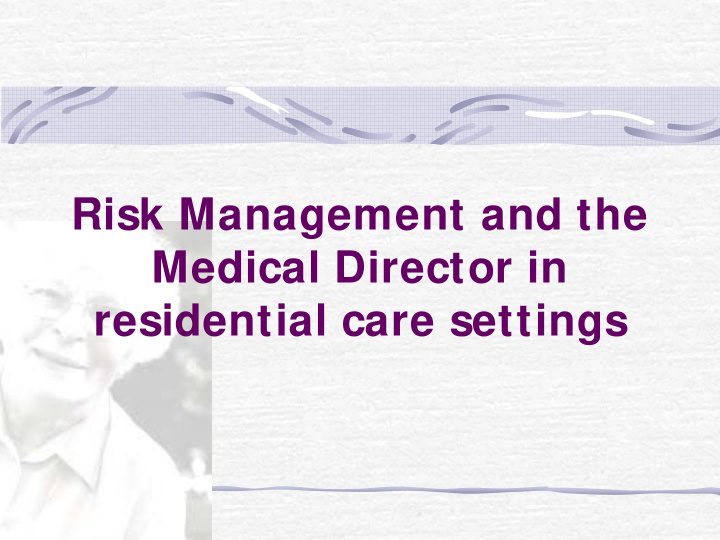



Risk Management and the Medical Director in residential care settings
Dr. Lynn B Beattie Medical Director, Vancouver Coastal Health & Providence Health Care, Professor, University of British Columbia Darren Kopetsky Risk Management, Vancouver Coastal Health
Outline Risk Management role of Medical Director Basics of Risk Management Resources for Medical Directors Application to specific situations Discussion
Role of Medical Director … responsible for the direction and coordination of medical care in the facility, which includes: advocating and supporting risk management program, working with administration, nursing staff and MDs to establish or refine processes and systems to reduce risks and prevent injuries
Risk is… the potential to affect the organization’s ability to achieve objectives successfully - includes threats and opportunities arising from strategic, operational, and financial activities. Strategic …doing the wrong things Operational …doing the right things the wrong way Financial …incurring financial loss Property…incurring property loss Hazard …incurring unacceptable business loss all have implications for resident safety
Risk management is… Prevention - identify and reduce or eliminate harmful risks (and leverage opportunity risks) Mitigation - minimize costs and consequences of incidents, and Remediation – consider provision for compensation, restoration and recovery
Phases in risk management: before an incident - prevention: 1) Identify & evaluate likelihood & impact (monitoring issues internally and in the field) 2) minimizing risks & cost; incident management should one occur - mitigation: 3) containing the effects of any damaging or harmful incident (involve coverage providers); and after an incident – remediation & learning: 4) with insurer, work toward restoration (possibly compensation); providing feedback of information as a basis for improving the management system.
High risk issues in LTC (likelihood x consequence) Medication errors, reactions Undiagnosed / untreated / unexpected conditions Decubitis ulcers Wandering behaviors Inappropriate discharges and transfers Resident injuries Resident falls Improperly applied DNACPR / advance directives
Resources Facility Colleagues Medical Director colleagues American Medical Directors Association (http://amda.com) Insurer / risk advisory contact – Health Authority Risk Management contact. Contracted centres - Marsh Canada (coverage provider) Public Guardian and Trustee of BC Literature
Application Cases
Case 1: Mr. A, 82 years old Ax to acute care with pneumonia and multiple problems Prior to admission he was living at home with his wife (tenuous health status, now post-stroke) Both transferred to extended care (acute medical needs). Able to walk with assistance (some unsteadiness) improved with use of cane Expressed concerns about money management & his home and wanted to be discharged. Son lived 200 km away; trial home visit with son unsuccessful $10,000 in his room, claimed there had been $100,000 – stolen?
Case 1 cont’d The Public Trustee involved re: access to his house; Locks changed; new keys to be sent to the care unit. Home visit planned, he refused to wait On arrival could not get in Suffered fall on steps and sustained a C1C2 fracture Treated in ER, acute, and transferred back to extended care. Continues to insist that he wants to be discharged home.
What are the risk issues? 1) prevention? 2) mitigation? 3) remediation?
Case 2 - Mr B., 46 years old Severe head injury, PVS Continuous tube feeding, started early in his hospital admission. Chronic lung problems, Requires respiratory toilet, suction and antibiotics. Transferred to extended care. Wife seeks says “Level 2” care but when acute respiratory distress, daughter insists he be “Level 3” care and transferred to acute. Occurs 3 times in 10 days; Daughter verbally abusive to staff and outspoken about insistence for transfer. Pressure from acute care to transfer him back to extended care
Levels of Intervention in XYZ Centre Level 1: Support care such as comfort measures, relief of pain, provision of fluids, control of symptoms from fever. Level 2: Therapeutic measures within the limits of the institution with supportive care as outlined in Level 1 and medications such as antibiotics when indicated. Level 3: Major intervention such as surgical treatment for a hip fracture in Acute Care but excluding admission to Intensive Care and cardiopulmonary resuscitation. Level 4: Maximum therapeutic effort as Level 3, and if necessary, admission to Intensive Care and cardiopulmonary resuscitation in the Acute Care.
What are the risk issues? 1) prevention? 2) mitigation? 3) remediation?
Discussion
Recommend
More recommend